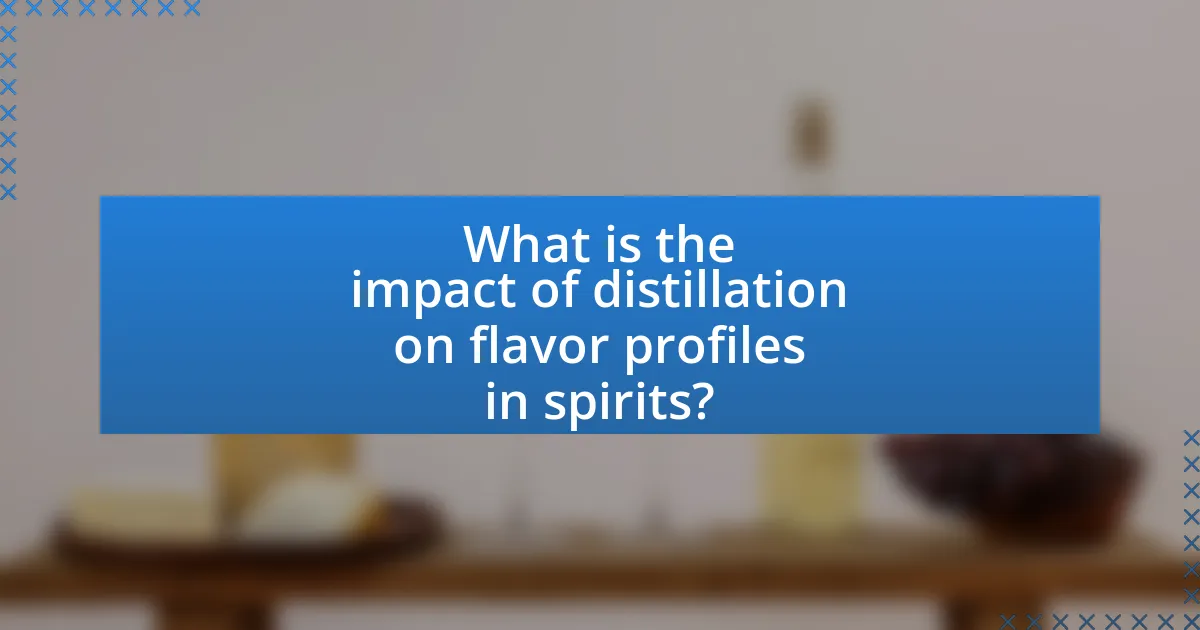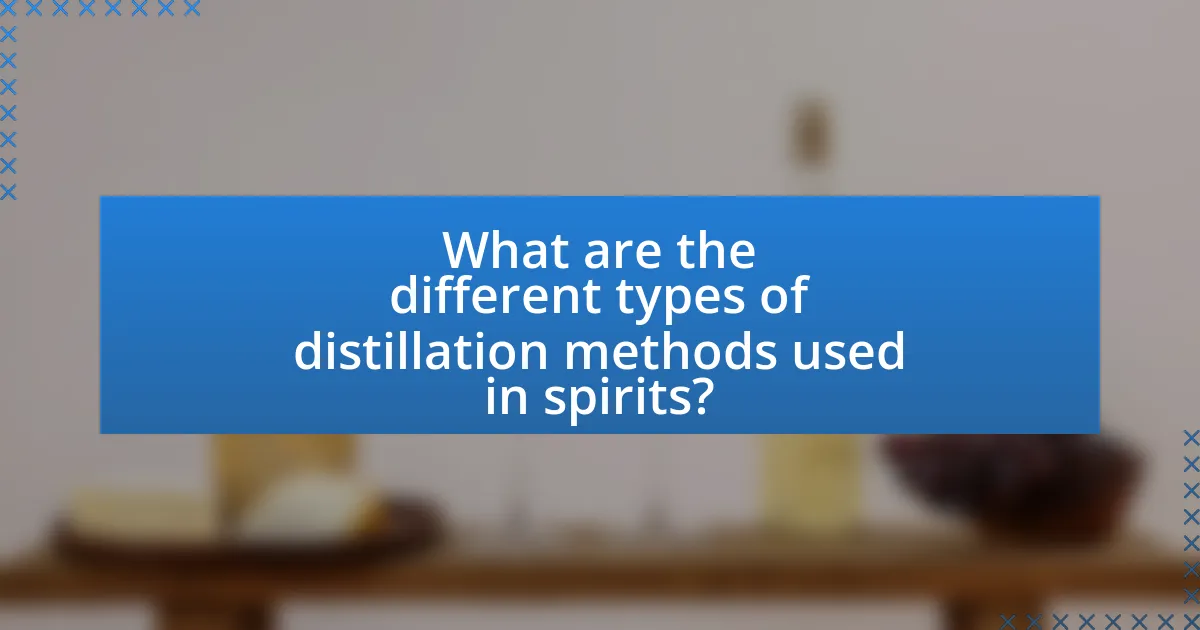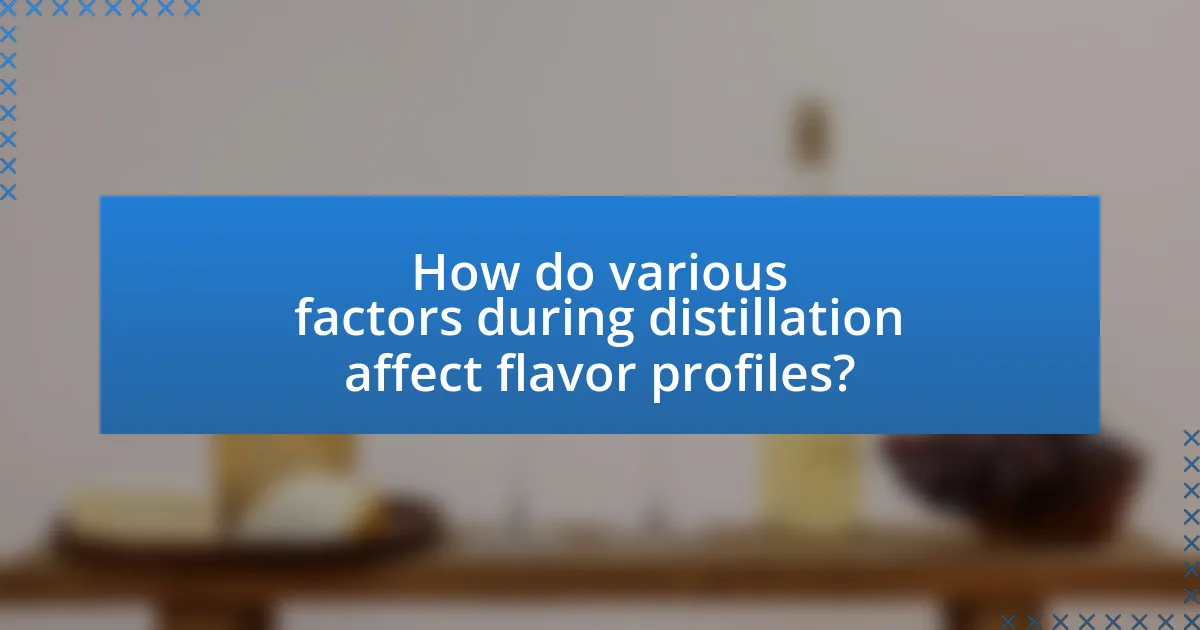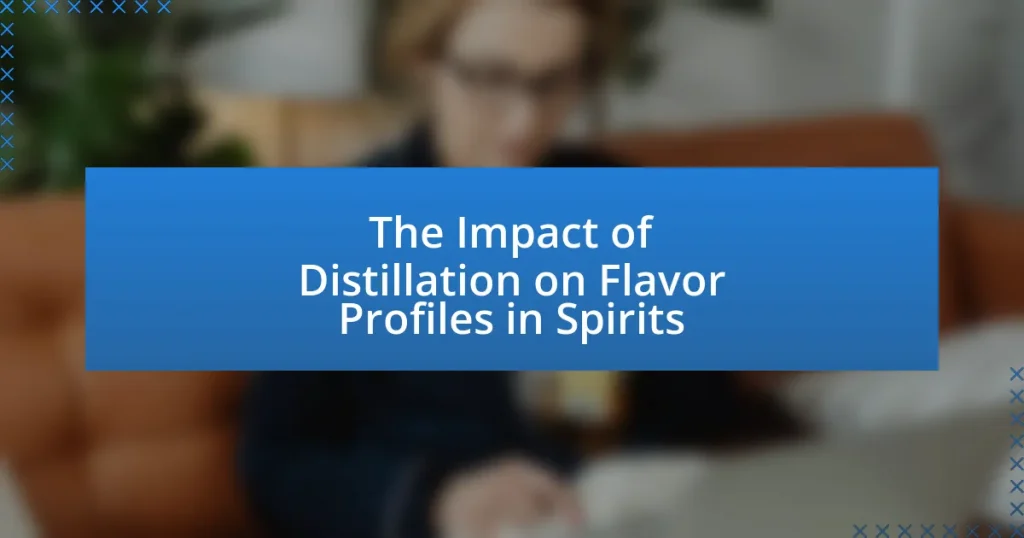The article examines the impact of distillation on flavor profiles in spirits, highlighting how the distillation process concentrates desirable compounds while removing unwanted elements. It discusses the key stages of distillation, including fermentation, distillation, and maturation, and how different methods, such as pot still and column still distillation, influence flavor outcomes. The article also emphasizes the importance of understanding flavor profiles in the spirits industry for product development and consumer preferences, detailing how factors like temperature control, raw materials, and fermentation conditions contribute to the final taste of distilled spirits. Additionally, practical tips for optimizing distillation processes to enhance flavor integrity are provided, along with common mistakes to avoid.

What is the impact of distillation on flavor profiles in spirits?
Distillation significantly impacts flavor profiles in spirits by concentrating desirable compounds while removing unwanted elements. During distillation, the heating process separates alcohol from the fermented mash, allowing for the extraction of volatile flavor compounds such as esters and phenols, which contribute to the spirit’s aroma and taste. For example, in whiskey production, the distillation process can enhance fruity or floral notes, depending on the distillation method and the type of still used. Additionally, the number of distillation runs influences the purity and intensity of flavors; multiple distillations often lead to a cleaner spirit with less complexity, while single distillation can retain more of the original character. This relationship between distillation and flavor is supported by studies showing that different distillation techniques yield varying flavor profiles, as seen in the distinct characteristics of pot still versus column still spirits.
How does distillation influence the overall flavor of spirits?
Distillation significantly influences the overall flavor of spirits by concentrating desirable compounds while removing unwanted impurities. This process allows for the extraction of specific flavor components, such as esters and phenols, which contribute to the spirit’s aroma and taste profile. For example, in whiskey production, the distillation process can enhance the rich, complex flavors derived from the grains and aging process, while also eliminating harsh alcohols that could detract from the final product. Studies have shown that different distillation techniques, such as pot still versus column still, can lead to distinct flavor profiles, with pot stills often producing more flavorful and aromatic spirits due to their ability to retain more congeners.
What are the key stages of the distillation process that affect flavor?
The key stages of the distillation process that affect flavor are fermentation, distillation, and maturation. During fermentation, yeast converts sugars into alcohol, producing various flavor compounds. In the distillation stage, the separation of alcohol from the wash occurs, where different boiling points allow for the extraction of specific flavor components; for example, the heads contain lighter, more volatile compounds, while the hearts contain the desired flavors. Finally, maturation in barrels allows for the interaction between the spirit and wood, further developing and enhancing the flavor profile through chemical reactions and absorption of compounds from the wood.
How do different distillation methods alter flavor profiles?
Different distillation methods significantly alter flavor profiles by influencing the separation of volatile compounds. For instance, pot still distillation retains more congeners, which are compounds that contribute to flavor and aroma, resulting in a richer and more complex spirit. In contrast, column still distillation typically produces a purer and lighter spirit due to its ability to separate unwanted compounds more effectively, leading to a cleaner taste. Research indicates that pot stills can enhance fruity and floral notes, while column stills often emphasize a smoother, more neutral profile. This distinction is crucial in the production of spirits like whiskey and vodka, where the choice of distillation method directly impacts the final flavor experience.
Why is understanding flavor profiles important in the spirits industry?
Understanding flavor profiles is crucial in the spirits industry because it directly influences product development, marketing strategies, and consumer satisfaction. Flavor profiles help distillers identify and enhance specific taste characteristics that appeal to target markets, ensuring that products meet consumer preferences. For example, a study by the American Distilling Institute highlights that spirits with well-defined flavor profiles can command higher prices and foster brand loyalty, as consumers are more likely to choose products that align with their taste preferences.
What role do flavor profiles play in consumer preferences?
Flavor profiles significantly influence consumer preferences by shaping the sensory experience associated with products. Consumers often gravitate towards specific flavor profiles that align with their taste preferences, which can be influenced by cultural background, personal experiences, and marketing. For instance, a study published in the Journal of Food Science found that flavor attributes such as sweetness, bitterness, and acidity directly affect consumer liking and choice, demonstrating that distinct flavor profiles can lead to increased product appeal and loyalty.
How do flavor profiles impact the marketing of spirits?
Flavor profiles significantly influence the marketing of spirits by shaping consumer preferences and brand positioning. Distinct flavor characteristics, such as sweetness, bitterness, or spiciness, help brands differentiate themselves in a competitive market, appealing to specific target demographics. For instance, a study by the Distilled Spirits Council of the United States found that 70% of consumers are more likely to purchase a spirit if they are aware of its unique flavor profile. This awareness drives marketing strategies that emphasize tasting notes and cocktail pairings, enhancing consumer engagement and brand loyalty.

What are the different types of distillation methods used in spirits?
The different types of distillation methods used in spirits include pot still distillation, column still distillation, and vacuum distillation. Pot still distillation involves a traditional method where fermented mash is heated in a pot still, allowing for the separation of alcohol from the mash, typically resulting in richer flavors. Column still distillation, also known as continuous distillation, utilizes a column still that allows for multiple distillation processes in one run, producing a higher alcohol content and a cleaner spirit. Vacuum distillation operates under reduced pressure, which lowers the boiling point of the liquid, preserving delicate flavors and aromas that might be lost in traditional methods. Each method significantly influences the flavor profiles of the resulting spirits, with pot stills often yielding more complex and robust flavors, while column stills produce lighter and purer spirits.
How does pot still distillation affect flavor profiles?
Pot still distillation significantly enhances the flavor profiles of spirits by allowing for a more selective separation of volatile compounds. This method retains a higher concentration of flavor compounds, such as esters and phenols, which contribute to the complexity and richness of the final product. Unlike column stills, pot stills operate in a batch process that permits the distiller to control the distillation cuts more precisely, capturing the desired flavors while leaving behind undesirable elements. Research indicates that spirits distilled in pot stills, such as single malt Scotch whisky, exhibit a broader range of flavors and aromas compared to those produced in continuous column stills, which tend to produce a cleaner but less complex spirit.
What unique characteristics does pot still distillation impart to spirits?
Pot still distillation imparts a rich, complex flavor profile to spirits, characterized by a fuller body and enhanced aromatic qualities. This method allows for a higher concentration of congeners, which are compounds that contribute to the taste and aroma, resulting in a more robust and nuanced spirit. Additionally, pot stills typically produce spirits with a higher alcohol by volume (ABV) and a smoother mouthfeel, as the distillation process retains more of the original ingredients’ flavors. Historical evidence shows that traditional pot stills, used in regions like Scotland and Ireland for whiskey production, have consistently yielded spirits that are celebrated for their depth and character, distinguishing them from those produced by column stills, which tend to be lighter and more neutral in flavor.
How does the size of the pot still influence flavor outcomes?
The size of the pot still significantly influences flavor outcomes by affecting the distillation process and the concentration of volatile compounds. Larger pot stills tend to produce a lighter spirit with a more subtle flavor profile due to increased reflux, which allows for more separation of heavier compounds. In contrast, smaller pot stills generally yield a richer and more complex flavor, as they retain more of the heavier, flavorful components during distillation. This phenomenon is supported by the fact that smaller stills create a higher surface area-to-volume ratio, enhancing the interaction between the vapor and liquid phases, which leads to greater flavor extraction.
What is the role of column still distillation in flavor development?
Column still distillation plays a crucial role in flavor development by allowing for the separation of volatile compounds based on their boiling points. This method enables distillers to selectively extract desirable flavor components while leaving behind unwanted impurities. The precise control over temperature and reflux ratios in column stills facilitates the production of spirits with distinct flavor profiles, as evidenced by the ability to create lighter, more refined spirits like vodka or more robust, complex flavors found in whiskey. Studies have shown that the efficiency of column still distillation can significantly influence the aromatic and taste characteristics of the final product, thereby directly impacting consumer perception and enjoyment.
How does column still distillation differ from pot still distillation?
Column still distillation differs from pot still distillation primarily in efficiency and the resulting purity of the spirit. Column stills, also known as continuous stills, allow for a continuous process of distillation, producing higher alcohol content and a cleaner spirit due to multiple distillation stages within the column. In contrast, pot stills operate in batches, resulting in lower alcohol content and a more complex flavor profile, as they retain more of the original ingredients’ characteristics. This distinction is significant in the production of spirits, as column distillation is often used for neutral spirits like vodka, while pot distillation is favored for richer, more flavorful spirits like whiskey and rum.
What flavors are typically enhanced through column still distillation?
Column still distillation typically enhances clean, light flavors such as floral, fruity, and citrus notes. This method allows for a higher separation of volatile compounds, resulting in a purer spirit with a more refined flavor profile. For example, spirits like vodka and gin often exhibit these enhanced characteristics due to the efficient removal of heavier, undesirable compounds during the distillation process.

How do various factors during distillation affect flavor profiles?
Various factors during distillation significantly influence flavor profiles by altering the composition of volatile compounds. The temperature at which distillation occurs affects the evaporation of different alcohols and congeners; for instance, higher temperatures can lead to the loss of delicate flavors while concentrating harsher notes. The type of distillation apparatus, such as pot stills versus column stills, also plays a crucial role; pot stills tend to retain more flavor compounds, resulting in a richer profile, whereas column stills produce a cleaner spirit with fewer flavor complexities. Additionally, the duration of distillation impacts flavor extraction; longer distillation times can enhance the concentration of certain flavors but may also strip away lighter, more nuanced notes. These factors collectively determine the final flavor profile of the distilled spirit, influencing its aroma, taste, and overall character.
What impact does temperature control have on flavor extraction?
Temperature control significantly influences flavor extraction during distillation. Higher temperatures can enhance the volatility of aromatic compounds, leading to a more pronounced flavor profile, while lower temperatures may result in a more delicate extraction of flavors. Research indicates that specific temperature ranges optimize the extraction of desirable compounds, such as esters and phenols, which contribute to the overall sensory experience of spirits. For instance, a study published in the Journal of Agricultural and Food Chemistry found that maintaining a distillation temperature between 78°C and 82°C maximizes the extraction of key flavor compounds in whiskey, demonstrating the critical role of precise temperature management in flavor development.
How does the boiling point of different ingredients influence flavor?
The boiling point of different ingredients significantly influences flavor by determining which compounds are released during the distillation process. Ingredients with lower boiling points, such as volatile aromatic compounds, evaporate first, contributing to the initial flavor profile of the spirit. For example, in the distillation of gin, botanicals like juniper release their essential oils at lower temperatures, enhancing the aromatic qualities of the final product. Conversely, ingredients with higher boiling points may remain in the distillation pot longer, leading to a more robust and less volatile flavor profile. This selective evaporation is crucial in crafting spirits, as it allows distillers to manipulate the flavor by controlling the temperature and timing of the distillation process.
What are the effects of cooling methods on flavor retention?
Cooling methods significantly affect flavor retention in spirits by influencing the volatility of aromatic compounds. Rapid cooling techniques, such as using liquid nitrogen or ice baths, can preserve delicate flavors by minimizing the evaporation of volatile compounds during the distillation process. Research indicates that maintaining lower temperatures during cooling can enhance the retention of esters and phenols, which are crucial for the overall flavor profile. For instance, a study published in the Journal of Agricultural and Food Chemistry found that spirits cooled quickly retained up to 30% more flavor compounds compared to those cooled slowly. This demonstrates that the choice of cooling method directly impacts the final taste and aromatic complexity of distilled spirits.
How do fermentation and raw materials contribute to flavor profiles during distillation?
Fermentation and raw materials significantly influence flavor profiles during distillation by determining the types of compounds produced and their concentrations. During fermentation, yeast converts sugars from raw materials into alcohol and various flavor compounds, such as esters and phenols, which contribute to the final taste. For example, the use of different grains in whiskey production, such as barley or corn, leads to distinct flavor characteristics due to the unique enzymes and sugars present in each grain. Additionally, the fermentation process can produce volatile compounds that carry over into the distillation phase, enhancing the complexity of the spirit. Research indicates that the choice of raw materials and fermentation conditions can lead to variations in flavor intensity and profile, as seen in studies comparing different yeast strains and fermentation temperatures, which affect the aromatic compounds generated.
What types of raw materials are commonly used in spirits production?
Common raw materials used in spirits production include grains, fruits, sugarcane, and potatoes. Grains such as barley, corn, rye, and wheat are essential for producing whiskey and vodka, while fruits like grapes and apples are primarily used for brandy and certain types of vodka. Sugarcane is the primary ingredient in rum production, and potatoes are commonly used in the production of some vodkas. These materials are fermented and distilled to create various spirits, influencing their flavor profiles significantly. For instance, the type of grain used in whiskey can impart distinct flavors, while the fermentation process of fruits in brandy can enhance fruity notes.
How does the fermentation process interact with distillation to shape flavor?
The fermentation process significantly influences the flavor profile of spirits during distillation by converting sugars into alcohol and producing various flavor compounds. Yeast activity during fermentation generates esters, phenols, and other volatile compounds that contribute to the aroma and taste of the final product. For example, the presence of specific yeast strains can enhance fruity or floral notes, which are then concentrated during distillation.
During distillation, the separation of alcohol from the fermented mash allows for the selective capture of these flavor compounds, as different compounds evaporate at different temperatures. This means that distillers can manipulate the distillation process to retain or remove certain flavors, shaping the overall character of the spirit. The interaction between fermentation and distillation is crucial; without fermentation, there would be no alcohol or flavor precursors to distill, and without distillation, the complex flavors developed during fermentation would not be effectively concentrated or refined.
What practical tips can enhance flavor profiles in spirits through distillation?
To enhance flavor profiles in spirits through distillation, distillers can utilize techniques such as selecting high-quality raw materials, controlling fermentation conditions, and optimizing distillation parameters. High-quality raw materials, such as specific grains or fruits, contribute distinct flavors that carry through the distillation process. Controlling fermentation conditions, including temperature and yeast selection, can influence the development of flavor compounds. Additionally, optimizing distillation parameters, such as the cut points during distillation, allows distillers to isolate desirable flavor compounds while removing unwanted ones. These practices are supported by the understanding that the choice of ingredients and precise control during distillation significantly impact the final flavor profile of the spirit.
How can distillers optimize their processes for better flavor outcomes?
Distillers can optimize their processes for better flavor outcomes by carefully controlling fermentation, distillation temperature, and aging conditions. Fermentation influences the production of flavor compounds; using specific yeast strains can enhance desirable flavors. During distillation, maintaining precise temperature control allows for the separation of volatile compounds, which can improve the overall flavor profile. Additionally, aging spirits in high-quality barrels can impart complex flavors, as the wood interacts with the spirit over time. Research indicates that spirits aged in new oak barrels can develop richer flavors due to the extraction of lignin and vanillin from the wood, enhancing the sensory experience.
What common mistakes should be avoided to preserve flavor integrity?
To preserve flavor integrity in spirits, avoid over-distillation, which can strip essential flavors and aromas. Over-distillation often leads to a neutral spirit that lacks the complexity of the original ingredients. Additionally, neglecting proper temperature control during distillation can result in undesirable compounds being carried over, negatively impacting flavor. Using low-quality raw materials also compromises flavor integrity, as the base ingredients significantly influence the final product’s taste profile. Lastly, improper aging conditions, such as exposure to excessive light or temperature fluctuations, can alter the flavor characteristics developed during maturation.


